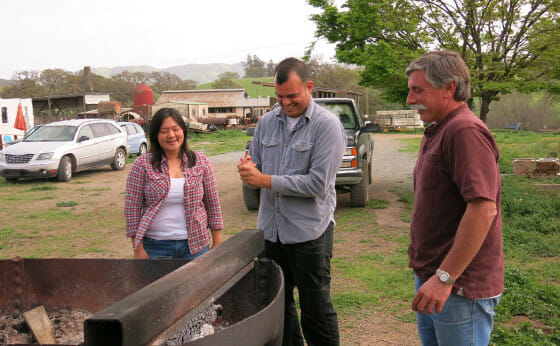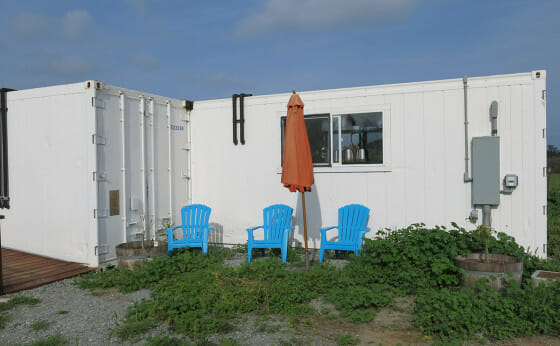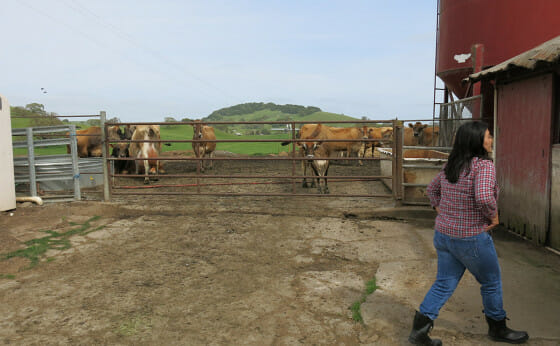Down on the Gelato Farm
Call it the new homesteading: two classically trained chefs built their gelato production facility right on a California dairy farm.
Down on the Gelato Farm
Call it the new homesteading: two classically trained chefs built their gelato production facility right on a California dairy farm.

A hopeful young couple leases a plot on an established farmer’s property. They’re at an early phase of their careers, not ready to own their own land. So they forge a partnership with their farmer/landlord for the mutual benefit of all.
But here’s the twist: in this case, the homesteaders are classically trained chefs (not farmers) and they’re harvesting gelato (not alfalfa).
Jennifer Ko and Alex Saneski met at the French Culinary Institute in Manhattan, 3,000 physical miles (and millions of symbolic ones) from the gentle hills of Petaluma, Calif. After clocking some experience at the legendary il laboratorio del gelato and other gelaterias, the couple started cooking up some West Coast dreams.

Like many chefs, Ko and Saneski were seduced by California’s gentle climes, and the access to amazing year-round produce. Citrus and figs and persimmons, oh my. They also wanted to partner directly with a Jersey dairy farm, obtaining their main ingredient straight from the source.
“My mother asks, ‘Why don’t you just buy ice cream mix…and save all the work?’” says Saneksi. “I tell her that real Italians would sniff their nose at gelato like that!”
Saneski says many of his colleagues obtain pre-sweetened ice cream base from larger dairies. The mix has cream, milk, sugar, and sometimes egg yolks, in a pre-determined ratio. Ko and Saneksi wanted more control.
They felt like a butterfat content of 14-16% was too high, leading the fat to overshadow quality ingredients. “I know, Americans like their fat,” said Saneski. “But it drowns out the flavors we want to showcase.”
They first started hunting for dairy producers in Ko’s home territory, Southern California. But they soon found they didn’t like the air quality or the enormity of the local farms. So they “followed the dairy” north, eventually finding a perfect farm one hour outside San Francisco.
John Taverna owns a 470-acre organic farm in Petaluma, supplying dairy to Organic Valley as well as the legendary cheese-maker, Cowgirl Creamery. But in 2009, Taverna said he was struggling to sell all his product. “During the recession, people were cutting corners at the supermarket,” he said. “Consumers that once may have bought organic were going with conventional to save a little money.”

So when Ko and Saneski approached him, looking to create a gelato-farm partnership, Taverna was thrilled. Their philosophies aligned, and he soon negotiated a novel arrangement.
Cremeux ex Machina was formed, a gelato production facility built within mooing distance of Taverna’s milking barn. It’s a modest little site, housed in one and a half cargo containers (the other half went to a nearby cheese-maker).

But inside their tiny containers, Ko and Saneski are quietly crafting a new kind of company. Instead of using someone else’s ice cream base, they procure raw milk directly from Taverna’s Jersey cows. At around 5.5% fat, Jerseys produce a naturally fatty milk that’s perfect for Cremeux ex Machina’s subtle creations. “We really don’t have to add cream at all,” said Saneski.
Unique amongst most of their colleagues, the couple pasteurizes all the milk themselves. It’s hard to imagine access to a fresher gelato base.
“My mother asks, ‘Why don’t you just buy ice cream mix from a dairy and save all the work?’” says Saneksi. “I tell her that real Italians would sniff their nose at gelato like that!”
They officially launched their company last October, and have slowly been increasing their exposure at farmer’s markets and local restaurants. They’re operating right in primo California farm territory, giving them direct access to many ingredients: walnuts, olive oil, avocados… .it’s enough to make an East Coast gelato maker drool.

Their carbon footprint is negligible, their product is fresh, and their ice cream base is self-made, but there’s a side bonus to Cremeux ex Machina’s operation: the pastoral life.
Saneski grew up in New Jersey with limited farm access, while Ko never spent time on a farm. Now they are there every day, hanging out with Taverna’s five chummy farm dogs, learning the idiosyncrasies of 150 cows, even getting to witness a few live cow births.
For Ko, spending every day on a farm has given her a sense of previously unknown peace. “It’s so soothing out here,” she said. “I’ll find myself in the middle of doing dishes, just mesmerized, staring out at the pasture and the ducks in the pond, and I’ll be like, ‘Wake up Jenny, there’s work to do!’”
Follow us
This work is licensed under a Creative Commons Attribution-NoDerivatives 4.0 International License.
Want to republish a Modern Farmer story?
We are happy for Modern Farmer stories to be shared, and encourage you to republish our articles for your audience. When doing so, we ask that you follow these guidelines:
Please credit us and our writers
For the author byline, please use “Author Name, Modern Farmer.” At the top of our stories, if on the web, please include this text and link: “This story was originally published by Modern Farmer.”
Please make sure to include a link back to either our home page or the article URL.
At the bottom of the story, please include the following text:
“Modern Farmer is a nonprofit initiative dedicated to raising awareness and catalyzing action at the intersection of food, agriculture, and society. Read more at <link>Modern Farmer</link>.”
Use our widget
We’d like to be able to track our stories, so we ask that if you republish our content, you do so using our widget (located on the left hand side of the article). The HTML code has a built-in tracker that tells us the data and domain where the story was published, as well as view counts.
Check the image requirements
It’s your responsibility to confirm you're licensed to republish images in our articles. Some images, such as those from commercial providers, don't allow their images to be republished without permission or payment. Copyright terms are generally listed in the image caption and attribution. You are welcome to omit our images or substitute with your own. Charts and interactive graphics follow the same rules.
Don’t change too much. Or, ask us first.
Articles must be republished in their entirety. It’s okay to change references to time (“today” to “yesterday”) or location (“Iowa City, IA” to “here”). But please keep everything else the same.
If you feel strongly that a more material edit needs to be made, get in touch with us at [email protected]. We’re happy to discuss it with the original author, but we must have prior approval for changes before publication.
Special cases
Extracts. You may run the first few lines or paragraphs of the article and then say: “Read the full article at Modern Farmer” with a link back to the original article.
Quotes. You may quote authors provided you include a link back to the article URL.
Translations. These require writer approval. To inquire about translation of a Modern Farmer article, contact us at [email protected]
Signed consent / copyright release forms. These are not required, provided you are following these guidelines.
Print. Articles can be republished in print under these same rules, with the exception that you do not need to include the links.
Tag us
When sharing the story on social media, please tag us using the following: - Twitter (@ModFarm) - Facebook (@ModernFarmerMedia) - Instagram (@modfarm)
Use our content respectfully
Modern Farmer is a nonprofit and as such we share our content for free and in good faith in order to reach new audiences. Respectfully,
No selling ads against our stories. It’s okay to put our stories on pages with ads.
Don’t republish our material wholesale, or automatically; you need to select stories to be republished individually.
You have no rights to sell, license, syndicate, or otherwise represent yourself as the authorized owner of our material to any third parties. This means that you cannot actively publish or submit our work for syndication to third party platforms or apps like Apple News or Google News. We understand that publishers cannot fully control when certain third parties automatically summarize or crawl content from publishers’ own sites.
Keep in touch
We want to hear from you if you love Modern Farmer content, have a collaboration idea, or anything else to share. As a nonprofit outlet, we work in service of our community and are always open to comments, feedback, and ideas. Contact us at [email protected].by Jesse Hirsch, Modern Farmer
April 8, 2013
Modern Farmer Weekly
Solutions Hub
Innovations, ideas and inspiration. Actionable solutions for a resilient food system.
ExploreExplore other topics
Share With Us
We want to hear from Modern Farmer readers who have thoughtful commentary, actionable solutions, or helpful ideas to share.
SubmitNecessary cookies are absolutely essential for the website to function properly. This category only includes cookies that ensures basic functionalities and security features of the website. These cookies do not store any personal information.
Any cookies that may not be particularly necessary for the website to function and are used specifically to collect user personal data via analytics, ads, other embedded contents are termed as non-necessary cookies.